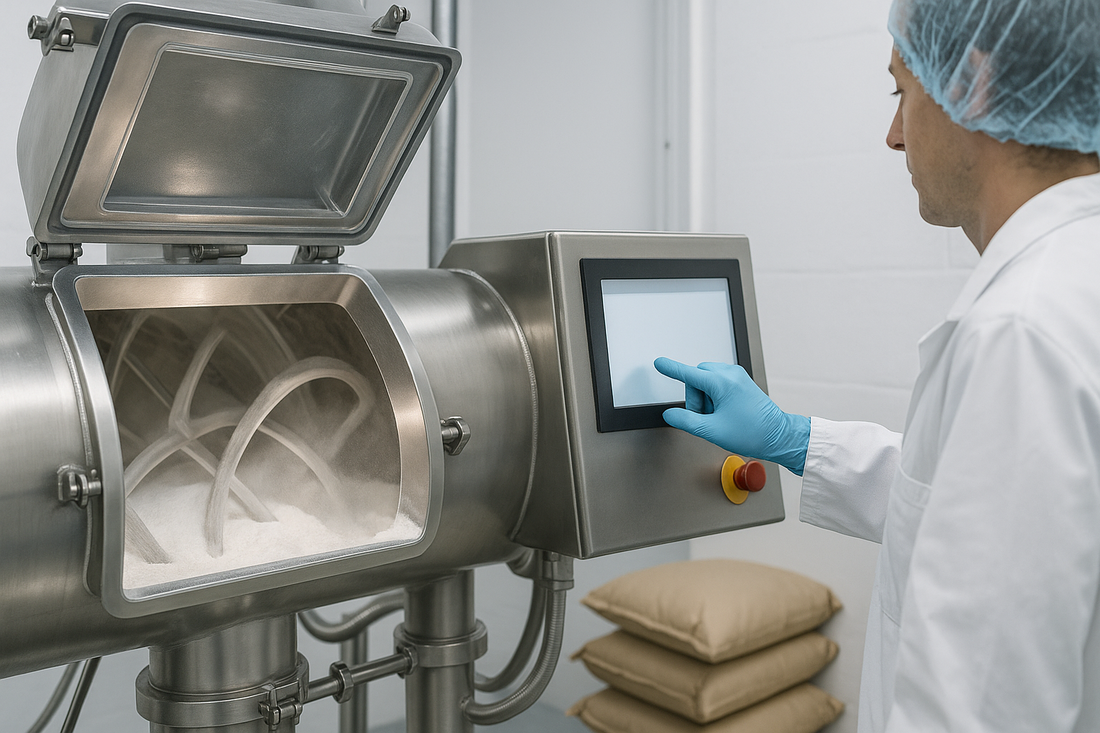Industrial mixing of solids: homogeneity, stability and performance
How to design, validate and scale blends to ensure quality, traceability and efficiency
In industrial manufacturing, raw-material mixing is not a formality—it’s a critical step that determines product stability, safety and performance. Poor mixing yields variability, rework and extra costs; robust mixing ensures consistent quality, scalability and efficiency. At PRO3S we design and execute tailored mixing processes for human and animal nutrition, detergency, biocides and industrial chemicals.
What defines a good mixing process
- Homogeneity and repeatability: uniform distribution of actives and excipients (control of CV or %RSD per specification) and lot-to-lot reproducibility.
- Particle-size and flow control: particle size, bulk density and flowability fit for the next operation (sieving, dosing, packaging).
- Addition sequence: correct order (preblend of minors, micro-dosed or sensitive ingredients) to avoid segregation and ensure effective presence of each component.
- Mechanical energy regime: time, speed, agitator type and shear level compatible with product integrity (preventing crystal breakage, delamination, hot spots).
- Environmental conditions: controlled humidity and temperature to avoid caking, static electricity or undesired absorptions.
- Physicochemical compatibility and use of anticaking agents or adsorbents when incorporating liquids into solids.
PRO3S capabilities for solid and solid–liquid blends
We select the optimal technology based on rheology, density, friability and process targets:
- Ribbon and paddle mixers for mid-to-large batches with competitive cycle times.
- Ploughshare mixers for intensive blending, preblends of minors and spray addition of liquids.
- Cone–screw mixer (low shear) for fragile products or particle integrity preservation.
- Drums/IBCs for formulations requiring low mechanical stress and quick changeovers.
- Liquid incorporation (fine spray) onto solids with anticaking/adsorbents to improve wettability, dust control or functionality.
Batch range: from 25 kg up to 3,000 kg (depending on density). Packaging into open or valve bags (sewn/heat-sealed), big bags and drums/pails. 100% traceability and labeling/coding aligned with client and regulatory requirements.
Process design and validation: from pilot to industrial scale
- Pre-studies: representative sampling, mixing curves and end-point definition (time/speed/fill level).
- Minor preblend for critical microdoses (vitamins, flavors, enzymes, pigments) to reduce segregation risk.
- Sampling plan (in-process and release) with defined acceptance criteria.
- Scale-up (DoE where applicable) and validation with three consecutive lots or per protocol.
- Cleaning validation and changeover times to prevent cross-contamination between families.
Quality, safety and regulatory compliance
We operate a mature, audited quality system: ISO 9001, ISO 14001, FSSC 22000 (human food) and GMP+ (animal feed). Segregated production and warehouse areas per sector; HACCP implemented; management software for full lot-level traceability. Sieving controls, metal detection and labeling per legislation and customer specifications.
Benefits for your operation
- Product consistency: specification-driven homogeneity, fewer returns and complaints.
- Cost optimization: less waste, fewer reworks, higher OEE and predictable cycle times.
- Agility: versatile equipment, fast setups and schedule reliability.
- Confidentiality and IP protection; we work exclusively as a third-party processor.
With over 10 years delivering blending processes for leading clients and three-shift operations, PRO3S is your partner to scale recipes, ensure homogeneity and reach the market with quality and speed.
Shall we discuss your formula?
We assess your specification (particle size, target CV, moisture, compatibility) and design the mixing cycle, sampling plan and optimal delivery format for your case. Request a pilot trial or a plant audit.
